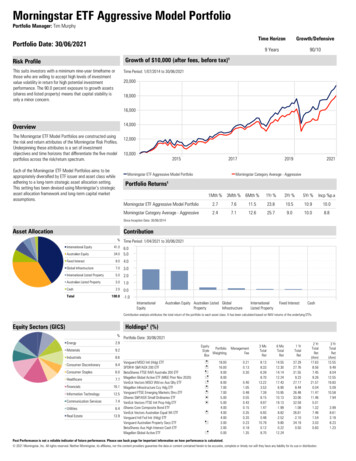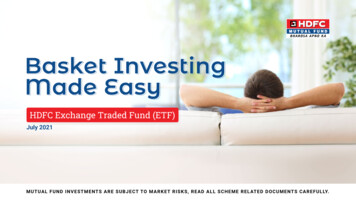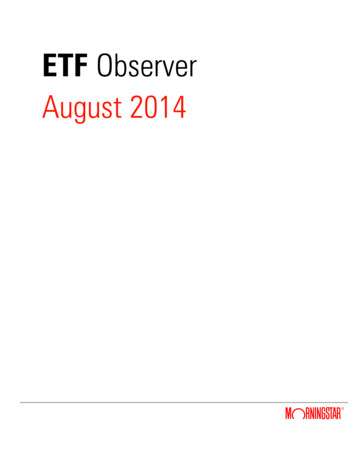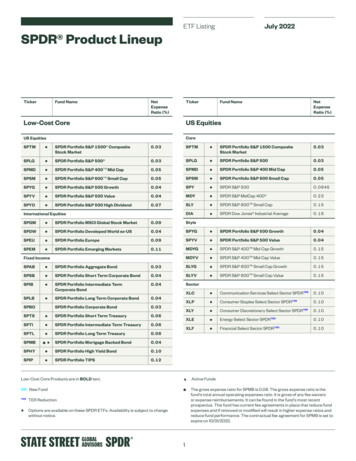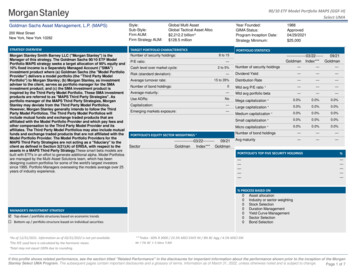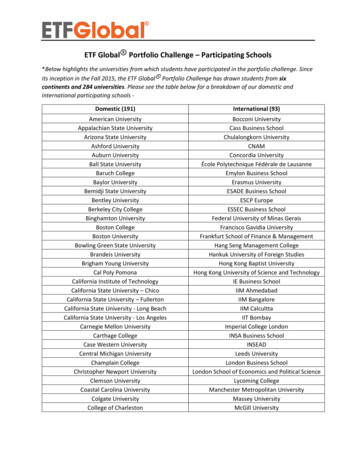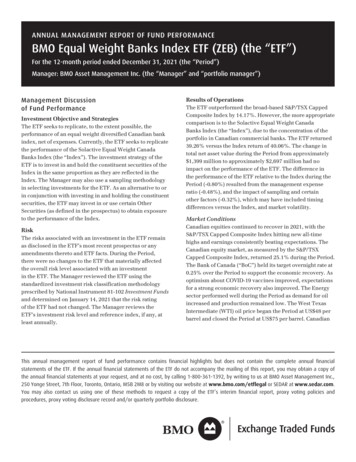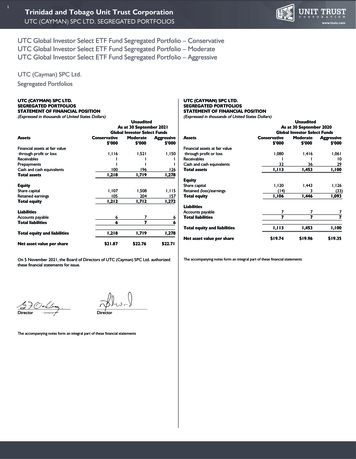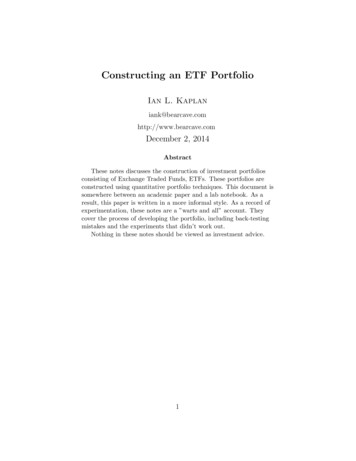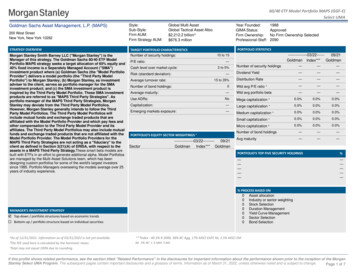
Transcription
60/40 ETF Model Portfolio MAPS (GGF-E)Select UMAGoldman Sachs Asset Management, L.P. (MAPS)200 West StreetNew York, New York 10282Style:Sub-Style:Firm AUM:Firm Strategy AUM:Global Multi AssetGlobal Tactical Asset Alloc 2,212.2 billion 676.3 millionSTRATEGY OVERVIEWTARGET PORTFOLIO CHARACTERISTICSMorgan Stanley Smith Barney LLC ("Morgan Stanley") is theManager of this strategy. The Goldman Sachs 60/40 ETF ModelPortfolio MAPS strategy seeks a target allocation of 60% equity and40% fixed income is a Separately Managed Account ("SMA")investment product where (a) Goldman Sachs (the "Model PortfolioProvider") delivers a model portfolio (the "Third Party ModelPortfolio") to Morgan Stanley; (b) Morgan Stanley, as investmentadviser to the client, serves as portfolio manager for the SMAinvestment product; and (c) the SMA investment product isinspired by the Third Party Model Portfolio. These SMA investmentproducts are referred to as "MAPS Third Party Strategies". Asportfolio manager of the MAPS Third Party Strategies, MorganStanley may deviate from the Third Party Model Portfolios.However, Morgan Stanley generally intends to follow the ThirdParty Model Portfolios. The Third Party Model Portfolios willinclude mutual funds and exchange traded products that areaffiliated with the Model Portfolio Provider and which pay fees andother compensation to the Third Party Model Provider and itsaffiliates. The Third Party Model Portfolios may also include mutualfunds and exchange traded products that are not affiliated with theModel Portfolio Provider. The Model Portfolio Providers for theMAPS Third Party Strategies are not acting as a "fiduciary" to theclient as defined in Section 3(21)(A) of ERISA, with respect to theassets in a MAPS Third Party Strategy.These smart beta models arebuilt with ETFs in an effort to generate additional alpha. Model Portfoliosare managed by the Multi-Asset Solutions team, which has beendesigning custom portfolios for some of the world's largest investorssince 1995. Portfolio Managers overseeing the models average over 25years of industry experience.Number of security holdings:1988ApprovedNo Firm Ownership Selected2090PORTFOLIO oldmanIndex*** Goldman10 to 15—P/E ratio:Cash level over market cycle:2 to 5%—Risk (standard deviation):15 to 35%Average turnover rate:0Number of bond holdings:Number of security holdings———Dividend Yield———Distribution Rate———Wtd avg P/E ratio ¹——————Mega capitalization 0.0%0.0%0.0%Large capitalization 0.0%0.0%0.0%Medium capitalization 0.0%0.0%0.0%Small capitalization 0.0%0.0%0.0%Micro capitalization 0.0%0.0%0.0%Number of bond holdings———Avg maturity———Average maturity:—Wtd avg portfolio betaUse ADRs:NoCapitalization:—Emerging markets exposure:—PORTFOLIO'S EQUITY SECTOR WEIGHTINGS --Index*** GoldmanPORTFOLIO'S TOP FIVE SECURITY HOLDINGS%——————————% PROCESS BASED ON0 Asset allocation0 Industry or sector weighting0 Stock Selection0 Duration Management0 Yield Curve Management0 Sector Selection0 Bond SelectionMANAGER'S INVESTMENT STRATEGY Top-down / portfolio structures based on economic trends Bottom-up / portfolio structure based on individual securities As of 12/31/2021. Information as of 03/31/2022 is not yet available.¹The P/E used here is calculated by the harmonic mean. Total may not equal 100% due to rounding.Year Founded:GIMA Status:Firm Ownership:Professional-Staff:***Index : 40.5% R 3000, 38% BC Agg, 17% MSCI EAFE Nt, 2.5% MSCI EMNt, 2% BC 1-3 Mth T-BillIf this profile shows related performance, see the section titled "Related Performance" in the disclosures for important information about the performance shown prior to the inception of the MorganStanley Select UMA Program. The subsequent pages contain important disclosures and a glossary of terms. Information as of March 31, 2022, unless otherwise noted and is subject to change.Page 1 of 7
60/40 ETF Model Portfolio MAPS (GGF-E)Select UMAMANAGER'S INVESTMENT PROCESSRISK CONSIDERATIONS The following Investment Process is that of the Model Portfolio Provider(rather than of the Money Manager (Morgan Stanley)). GSAM’s dynamic asset allocation approach combines strategic,long-term views with tactical tilts to create a diversified strategy that aimsto balances risk and return while navigating changing markets. EachModel Portfolio is carefully constructed to meet a specific risk profile andimplemented across a variety of asset classes and sub-asset classes inan effort to maximize diversification. Asset allocation investment decisions are made using a team-basedapproach, through the Models Working Group. This group is comprisedof senior investors from the Multi-Asset Solutions team, including theteam’s Chief Investment Officer, who meet weekly to discuss andoversee the Model Portfolio asset allocation strategy and monitor themarkets. The investment process begins with a multi-factor based assetallocation to help inform strategic, long-term positioning. Then, theModels Working Group debates the results, applying shorter-termtactical views that the group believes will best position the portfolios forrisk-adjusted performance. The final dynamic positioning is agreed uponthrough a vote by the Models Working Group. When the asset allocation strategy is finalized, the team selects fundsto complete the construction of the Model Portfolio. Goldman SachsModel Portfolios are built with smart beta GSAM ETFs in an effort togenerate additional alpha. Access and ActiveBeta ETFs, included inthese Model Portfolios, are designed to build on the traditional benefits ofETFs by seeking to provide intelligent market exposure and outperformindex-based solutions.Please consider the investment objectives,risks, charges and expenses of the exchange traded fund(s)carefully before investing. The prospectus contains this and otherinformation about the fund(s). To obtain a prospectus, contact yourfinancial advisor. Please read the prospectus carefully beforeinvesting.An investment in an exchange-traded fund involves riskssimilar to those of investing in a portfolio of equity securities traded onexchange in the relevant securities market, such as market fluctuationscaused by such factors as economic and political developments,changes in interest rates and perceived trends in stock prices. Theinvestment return and principal value of ETF investments will fluctuate,so that an investor's ETF shares, if or when sold, may be worth more orless than the original cost.Investing in securities entails risks, including: Equity portfoliosare subject to the basic stock market risk that a particularsecurity, or securities in general, may decrease in value. FixedIncome securities may be sensitive to changes in prevailinginterest rates. When rates rise the value generally declines.There is no assurance that the private guarantors or insurers willmeet their obligations. International investing should beconsidered one component of a complete and diversifiedinvestment program. Investing in foreign markets entails greaterrisks than those normally associated with domestic marketssuch as foreign political, currency, economic and market risks.Equity securities' prices may fluctuate in response to specificsituations for each company, industry, market conditions andgeneral economic environment. Companies paying dividendscan reduce or cut payouts at any time. Growth investing doesnot guarantee a profit or eliminate risk. The stocks of thesecompanies can have relatively high valuations. Because ofthese high valuations, an investment in a growth stock can berisky than an investment in a company with more modest growthexpectations. Value investing does not guarantee a profit oreliminate risk. Not all companies whose stocks are consideredto be value stocks are able to turn their business around orsuccessfully employ corrective strategies which would result instock prices that do not rise as initially expected. Bonds ratedbelow investment grade may have speculative characteristicsand present significant risks beyond those of other securities,including greater credit risk and price volatility in the secondarymarket. Investors should be careful to consider these risksalongside their individual circumstances, objectives and risktolerance before investing in high-yield bonds. If a strategyexpects to hold a concentrated portfolio of a limited number ofsecurities, it should be noted that a decline in the value of theseinvestments would cause the portfolio’s overall value to declineto a greater degree than that of a less concentratedportfolio.The returns on a portfolio consisting primarily ofsustainable investments may be lower or higher than a portfoliothat is more diversified or where decisions are based solely oninvestment considerations. Because sustainability criteriaexclude some investments, investors may not be able to takeadvantage of the same opportunities or market trends asinvestors that do not use such criteria. As of 12/31/2021. Information as of 03/31/2022 is not yet available.¹The P/E used here is calculated by the harmonic mean. Total may not equal 100% due to rounding.PORTFOLIO'S ALLOCATION HISTORY (%) 03/22FIXED INCOME SECTOR DISTRIBUTION12/2109/2106/21(%) 03/2212/2109/2106/21***Index : 40.5% R 3000, 38% BC Agg, 17% MSCI EAFE Nt, 2.5% MSCI EMNt, 2% BC 1-3 Mth T-BillIf this profile shows related performance, see the section titled "Related Performance" in the disclosures for important information about the performance shown prior to the inception of the MorganStanley Select UMA Program. The subsequent pages contain important disclosures and a glossary of terms. Information as of March 31, 2022, unless otherwise noted and is subject to change.Page 2 of 7
60/40 ETF Model Portfolio MAPS (GGF-E)Select UMARISK/RETURN ANALYSIS - 5 YEARS ENDING 03/31/22AVERAGE ANNUAL TOTAL RETURN (%) - PERIODS ENDING 03/31/22RateRateofofReturnsReturnsStandard Deviation (%)STDGoldman (Gross)Goldman (Net)40.5% R 3000, 38% BC Agg, 17% MSCIEAFE Nt, 2.5% MSCI EM Nt, 2% BC 1-3Mth T-Bill Index90-Day T-BillsROR11.6711.6311.398.376.178.720.461.09RISK VOLATALITY (%)RateGoldman (Gross)Goldman (Net)40.5% R 3000, 38% BCAgg, 17% MSCI EAFENt, 2.5% MSCI EM Nt,2% BC 1-3 Mth T-BillPORTFOLIO'S QUARTERLY RETURNS (%)IndexQuarter1Quarter2Quarter3Gross Net Gross Net Gross Net201720182019202020212022ofReturnsAnnual Rates of Return (%)20172018INVESTMENT RESULTS5.344.80-0.60 -1.098.858.32-11.72 -12.181.811.28-6.22 .260.994.67-1.09Select UMA20205 Year - Ending 03/31/222021 Annual Std. 211.39Quarter4Gross ORTFOLIO'S RISK STATISTICS - “ PERIODS ENDING03/31/22 ¹ ²3 Year5 YearStandard DeviationStandard Deviation of PrimaryBenchmarkSharpe RatioSharpe Ratio of PrimaryBenchmarkAlphaBetaDownside RiskR-SquaredTracking ErrorInformation .23**01/01/22-03/31/22Number OfGoldman (Gross)Goldman (Net)40.5% R 3000, 38% BC Agg, 17% MSCIEAFE Nt, 2.5% MSCI EM Nt, 2% BC 1-3Mth T-Bill IndexUp Qtrs.Down Qtrs.146141565PORTFOLIO DIVERSIFICATION - R²(INCEPTION THROUGH 12/14) Goldman vs. 40.5% R 3000, 38% BC Agg, 17% MSCIEAFE Nt, 2.5% MSCI EM Nt, 2% BC 1-3 Mth T-Bill Index Statistics are calculated using gross of fee performance only.R²0.981. Statistics are calculated using gross of feeperformance only.2. 40.5% R 3000, 38% BC Agg, 17% MSCI EAFE Nt,2.5% MSCI EM Nt, 2% BC 1-3 Mth T-Bill Index wasused as the primary benchmark and the 90-DayT-Bills Index as the risk-free benchmark.See important notes and disclosures pages for a discussion of the sources of the performance data used to calculate the performance results and related analyses shown above.If this profile shows related performance, see the section titled "Related Performance" in the disclosures for important information about the performance shown prior to the inception of the MorganStanley Select UMA Program. The subsequent pages contain important disclosures and a glossary of terms. Information as of March 31, 2022, unless otherwise noted and is subject to change.Page 3 of 7
60/40 ETF Model Portfolio MAPS (GGF-E)Select UMACOMPOSITE DISCLOSURESThe disclosures provided below apply to performance information in this profile, if any. Pastperformance is not a guarantee of future results. Actual individual account results may differfrom the performance shown in this profile. There is no guarantee that this investment strategywill achieve its intended results under all market conditions. Do not rely upon this profile as thesole basis for your investment decisions.Performance results in this profile are calculated assuming reinvestment of dividends and income.Returns for more than one calendar year are annualized and based on quarterly data. Returns forperiods of less than a calendar year show the total return for the period and are not annualized. Norepresentation is being made that any portfolio will or is likely to achieve profits or losses similar tothose shown. Returns will fluctuate and an investment upon redemption may be worth more or lessthan its original value. Performance shown does not reflect the impact of fees and expenses of theunderlying mutual fund and ETFs, as applicable.Sources of Performance Results and Other Data: The performance data and certain otherinformation for this strategy (including the data on page 1 of this profile) may include one or more ofthe following: (i) the performance results of a composite of Morgan Stanley accounts managed by thethird party investment manager, (ii) the performance results for accounts and investment productsmanaged by the third party investment manager, in the same or a substantially similar investmentstrategy outside of the applicable Morgan Stanley program, and/or (iii) in the case of Model PortfolioStrategies, the Model Portfolio Provider’s results in managing accounts outside of the Morgan StanleySelect UMA program prior to Model Portfolio Strategy’s inception in the Morgan Stanley Select UMAprogram . For periods through June 2012, the Fiduciary Services program operated through twochannels – the Morgan Stanley channel and the Smith Barney channel and any performance andother data relating to Fiduciary Services accounts shown here for these periods is calculated usingaccounts in only one of these channels.) Please note that the Fiduciary Services program was closedon January 2, 2018. Although the Fiduciary Services and Select UMA programs are both MorganStanley managed account programs, the performance results and other features of similar investmentstrategies in the two programs may differ due to investment and operational differences. Performancein one program is not indicative of potential performance in the other. For example, the individualinvestment strategies in Select UMA program accounts may contain fewer securities, which would leadto a more concentrated portfolio. The automatic rebalancing, wash sale loss and tax harvestingfeatures of the Select UMA program, which are not available in Fiduciary Services, also could causedifferences in performance. In addition, any performance results included in this profile that are basedon a third party investment manager’s accounts that are not part of the Morgan Stanley programaccounts or institutional accounts that are part of the Model Portfolio strategy may differ due toinvestment and operational differences as well. As such, performance results of the third partyinvestment manager's composites and the third party Model Portfolio Strategies may differ from thoseof Select UMA accounts managed in the same or a substantially similar investment strategy. Forexample, in the case of Model Portfolio Strategies, Morgan Stanley, as the investment manager, maydeviate from the Third Party Model Portfolios.Related Performance:The performance data represents the returns of a composite of 37 account(s) with a market value of 4.2 million as of 03/31/2022.In this profile, the performance from August 1, 2021, consists of the performance of all single styleSelect UMA accounts managed by Morgan Stanley in this strategy based on a Third Party ModelPortfolio provided by the Model Portfolio Provider, subject to any other limitations stated in this profile.Performance composites calculated by Morgan Stanley include all fee paying portfolios with noinvestment restrictions that are invested in accordance with this investment strategy based on a ThirdParty Model Portfolio provided by the Model Portfolio Provider. New accounts are included beginningwith the second full calendar month of performance. Terminated accounts are removed in the month inwhich they terminate (but prior performance of terminated accounts is retained). Performance iscalculated on a total return basis and by asset weighting the individual portfolio returns using thebeginning of period values.Morgan Stanley Performance:Gross Performance: Goldman’s Model Portfolio Provider gross performance results do not reflect thededuction of any investment advisory fees or program fees charged by the Model Portfolio Provider orMorgan Stanley. In the case of Fund Performance, the gross results also do not reflect the deductionof any fees and expenses internal to the mutual fund responsible for generating the performance,commissions charged on securities transactions, and other expenses attributable to such mutualfunds. The deduction of such fees and expenses, and the compounding effect of such fees over time,will reduce returns over time.Net Performance for all Periods:Net performance data represents the returns of a composite ofaccounts, assuming the deduction of a model fee ("Model Fee") that is equivalent to 0.5175%quarterly. The Model Fee consists of three components: 0.5%, which represents the maximumquarterly Morgan Stanley Advisory Fee and the 0.0175% maximum quarterly Program Overlay Fee(which, together cover the maximum fees for services provided by Morgan Stanley), plus 0.0%quarterly SMA Manager Fees. The Model Portfolio Provider does not charge a fee for delivering theThird Party Model Portfolio to Morgan Stanley. The SMA Manager Fees may differ from manager tomanager, and managers may change their fee to new clients from time to time. If you select thismanager for your account, check the SMA Manager Fees specified in the written client agreement, incase these have changed since you received this profile. Historical net fees reflect the Advisory FeeSchedule as of October 1, 2018. Morgan Stanley program fees have a compounding effect onperformance, which will reduce returns over time. The Morgan Stanley program fee, which differsamong programs and clients, is described in the applicable Morgan Stanley ADV brochure, which isavailable at www.morganstanley.com/ADV or on request from your Financial Advisor or Private WealthAdvisor.Morgan Stanley program fees are calculated quarterly for the performance illustrated in this profile,and have a compounding effect on performance. The Morgan Stanley program fee, which differsamong programs and clients, is described in the applicable Morgan Stanley ADV brochure, which isavailable at www.morganstanley.com/ADV or on request from your Financial Advisor or Private WealthAdvisor.Document approval date 04/2021. #CRC 3544766Focus List, Approved List, and Watch Status:If this profile shows related performance, see the section titled "Related Performance" in the disclosures for important information about the performance shown prior to the inception of the MorganStanley Select UMA Program. The subsequent pages contain important disclosures and a glossary of terms. Information as of March 31, 2022, unless otherwise noted and is subject to change.Page 4 of 7
60/40 ETF Model Portfolio MAPS (GGF-E)Select UMAGlobal Investment Manager Analysis ("GIMA") uses two methods to evaluate investment products inapplicable advisory programs. In general, strategies that have passed a more thorough evaluation maybe placed on the "Focus List", while strategies that have passed through a different and lesscomprehensive evaluation process may be placed on the "Approved List". Sometimes an investmentproduct may be evaluated using the Focus List process but then placed on the Approved List insteadof the Focus List.Investment products may move from the Focus List to the Approved List, or vice versa. GIMA may alsodetermine that an investment product no longer meets the criteria under either evaluation process andwill no longer be recommended in investment advisory programs (in which case the investmentproduct is given a "Not Approved" status).GIMA has a "Watch" policy and may describe a Focus List or Approved List investment product asbeing on "Watch" if GIMA identifies specific areas that (a) merit further evaluation by GIMA and (b)may, but are not certain to, result in the investment product becoming "Not Approved". The Watchperiod depends on the length of time needed for GIMA to conduct its evaluation and for the investmentmanager to address any concerns. GIMA may, but is not obligated to, note the Watch status in thisreport with a "W" or "Watch" on the cover page.For more information on the Focus List, Approved List, and Watch processes, please see theapplicable Morgan Stanley ADV brochure (www.ms.com/adv). Your Financial Advisor or Private WealthAdvisor can provide on request a copy of a paper entitled "GIMA: At A Glance ".The portfolio may, at times, invest in exchange-traded funds (ETFs), which are a form of equitysecurity in seeking to maintain continued full exposure to the broad equity market.Morgan Stanley investment advisory programs may require a minimum asset level and, depending onyour specific investment objectives and financial position, may not be suitable for you. Investmentadvisory program accounts are opened pursuant to a written client agreement.Consulting Group’s unified managed account program, Select UMA, allows Financial Advisors tocombine separately managed accounts (SMAs), mutual funds and exchange-traded funds (ETFs)within a single investment advisory account for clients.Certain strategies managed or sub-advised by us or our affiliates, including but not limited to MorganStanley Investment Management and Eaton Vance Management and its investment affiliates, may beincluded in your account. Morgan Stanley Global Investment Manager Analysis evaluates certaininvestment products for the purposes of some – but not all – of Morgan Stanley Smith Barney LLC’sinvestment advisory programs. Please contact your Morgan Stanley team and/or see the applicableForm ADV, which can be accessed at www.morganstanley.com/adv, for information about affiliatedinvestment products that are not reviewed or evaluated by GIMA, as well as additional disclosuresapplicable to affiliated products, that could be included in this strategy.ADDITIONAL DISCLOSURESActual account holdings, performance and other data will vary depending on the size of an account,cash flows within an account, and restrictions on an account. Holdings are subject to change daily. Theinformation in this profile is not a recommendation to buy, hold or sell securities.Actual portfolio statistics may vary from target portfolio characteristics.The Top Five Portfolio Holdings listed herein are provided for informational purposes only and shouldnot be deemed to be a recommendation to purchase or sell the securities mentioned. Portfoliocharacteristics in this profile are based on an allocation weight in the strategy model. There are noguarantees that any of the securities mentioned will be held in a client’s account. It should not beassumed that the securities transactions or holdings discussed were or will prove to be profitable.The Model Portfolio Provider or Investment Manager may use the same or substantially similarinvestment strategies, and may hold similar portfolios of investments, in other portfolios or products itmanages (including mutual funds). These may be available at Morgan Stanley or elsewhere, and maycost an investor more or less than this strategy in Morgan Stanley's Select UMA program.Overlay Managers or Executing Sub-Managers in some of Morgan Stanley’s Separately ManagedAccount programs may affect transactions through broker-dealers other than Morgan Stanley or ouraffiliates. If your manager trades with another firm, you may be assessed costs by the other firm inaddition to Morgan Stanley’s fees. Those costs will be included in the net price of the security, notseparately reported on trade confirmations or account statements. Certain managers have historicallydirected most, if not all, of their trades to outside firms. Information provided by managers concerningtrade execution away from Morgan Stanley is summarized s/pdfs/adv/sotresponse.pdf. For more informationon trading and costs, please refer to the ADV Brochure for your program(s), available atwww.morganstanley.com/ADV, or contact your Financial Advisor/Private Wealth Advisor.Diversification does not guarantee a profit or protect against a loss.No obligation to notifyMorgan Stanley has no obligation to notify you when information in this profile changes.Sources of informationMaterial in this profile has been obtained from sources that we believe to be reliable, but we do notguarantee its accuracy, completeness or timeliness. Third party data providers make no warranties orrepresentations relating to the accuracy, completeness or timeliness of the data they provide and arenot liable for any damages relating to this data.No tax adviceMorgan Stanley and its affiliates do not render advice on legal, tax and/or tax accounting matters toclients. Each client should consult his/her personal tax and/or legal advisor to learn about any potentialtax or other implications that may result from acting on a particular recommendation.Not an ERISA fiduciaryMorgan Stanley is not acting as a fiduciary under either the Employee Retirement Income Security Actof 1974, as amended, or under section 4975 of the Internal Revenue Code of 1986, as amended, inproviding the information in this profile. 2019 Morgan Stanley Smith Barney LLC Member SIPC.INDEX DESCRIPTIONSIf this profile shows related performance, see the section titled "Related Performance" in the disclosures for important information about the performance shown prior to the inception of the MorganStanley Select UMA Program. The subsequent pages contain important disclosures and a glossary of terms. Information as of March 31, 2022, unless otherwise noted and is subject to change.Page 5 of 7
60/40 ETF Model Portfolio MAPS (GGF-E)Select UMA40.5% R 3000, 38% BC Agg, 17% MSCI EAFE Nt, 2.5% MSCI EM Nt, 2% BC 1-3 Mth T-Bill IndexDividend a portion of a company's profit paid to common and preferred shareholders.40.5% Russell 3000, 38% BC Aggregate, 17% MSCI EAFE Net, 2.5% MSCI EM Net, 2% BC 1-3 MthT-Bill (Short Treasury)Dividend Yield annual dividend per share divided by price per share. Dividend Yield for the portfolio isa weighted average of the results for the individual stocks in the portfolio.90-Day T-BillsThe 90-Day Treasury Bill is a short-term obligation issued by the United States government. T-bills arepurchased at a discount to the full face value, and the investor receives the full value when theymature. The difference of discount is the interested earned. T-bills are issued in denominations of 10,000 auction and 1,000 increments thereafter.Downside Risk is a measure of the risk associated with achieving a specific target return. Thisstatistic separates portfolio volatility into downside risk and upside uncertainty. The downsideconsiders all returns below the target return, while the upside considers all returns equal to or abovethe target return.Duration is a measure of price sensitivity expressed in years.S&P 500High Grade Corporate Bonds corporate bonds from issuers with credit ratings of AA or AAA.The S&P 500 Total Return has been widely regarded as the best single gauge of the large cap U.S.equities market since the index was first published in 1957. The index has over 5.58 trillionbenchmarked, with index assets comprising approximately 1.31 trillion of this total. The indexincludes 500 leading companies in leading industries of the U.S. economy, capturing 75% coverage ofU.S. equities. This index includes dividend reinvestment.Indices are unmanaged and have no expenses. You cannot invest directly in an index.GLOSSARY OF TERMSAlpha is a mathematical estimate of risk-adjusted return expected from a portfolio above and beyondthe benchmark return at any point in time.American Depositary Receipts (ADRs) are receipts for shares of a foreign-based corporation held inthe vault of a U.S. bank.Average Portfolio Beta is a measure of the sensitivity of a benchmark or portfolio's rates of return tochanges against a market return. The market return is the S&P 500 Index. It is the coefficientmeasuring a stock or a portfolio's relative volatility.Beta is a measure of the sensitivity of a portfolio's rates of return to changes in the market return. It isthe coefficient measuring a stock or a portfolio's relative volatility.Bottom-Up Stock Selection Emphasis primarily on individual stock selection. Considerations ofeconomic and industry factors are of secondary importance in the investment decision-makingprocess.Capitalization is defined as the following: Mega (Above 100 billion), Large ( 12 to 100 billion),Medium ( 2.5 - 12 billion), Small ( .50 - 2.5 billion) and Micro (below .50 billion).Distribution Rate is defined as the most recent distribution paid, annualized, and then divided by thecurrent market price. Distribution rate may consist of investment
60/40 ETF Model Portfolio MAPS (GGF-E) Select UMA 200 West Street Goldman Sachs Asset Management, L.P. (MAPS) PORTFOLIO STATISTICS . Sub-Style: Global Tactical Asset Alloc 676.3 millionFirm Strategy AUM: TARGET PORTFOLIO CHARACTERISTICS Number of security holdings: 10 to 15
